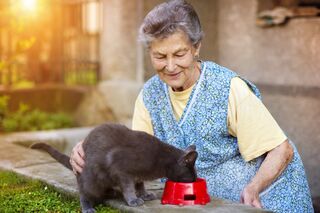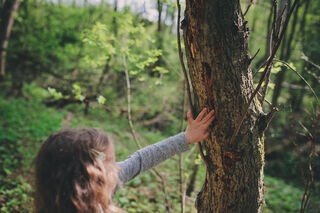Animal Behavior
Seeing Pets as Human
How do pets become more to us than just animals?
Posted July 9, 2020 Reviewed by Kaja Perina

On a Roman grave, an epitaph reads “To Helena, foster child, soul without comparison and deserving of praise.” Perhaps surprisingly, the deceased is not the author’s foster-child. In fact, Helena is not even human, but the owner’s beloved pet, forever memorialized for those who follow. Aside from the beautiful words and touching message, what may be the most psychologically interesting aspect of this epitaph is how human the owner conceptualized their pet. The author remembers Helena by name, and gives her an identity and personal history over and above that of a common animal. The owner also refers to Helena not as a pet but as a ‘foster child’ and references her soul, what many believe to be the very element separating us from other animals. This owner clearly sees no such separation.
What makes us see an animal as human? Is it something we are all capable of, or only some, or only in certain situations? Why do we do it at all, and what are the consequences? The answer is closely tied to a number of psychological concepts, including anthropomorphism, empathy and loneliness, and has important consequences for environmentalism, animal protection, and even our own health and wellbeing.
Anthropomorphism is a term for seeing the human in the non-human. Henry the Hoover, for instance, with his eyes above the vacuum, endears us to him, as we associate an appliance with a little bit of sentience. Indeed, we can be primed to see the human in the non-human in a number of ways. Faces, of course, get our human minds turning; marketing researchers will tell you that an easy way to improve product sales is to make the product or brand more human, hence the success of Ronald McDonald, Mickey Mouse and the Jolly Green Giant. We also see the human in the unexpected; when our printer starts spitting out paper it’s ‘going crazy,’ but when it’s dutifully rolling out our copies it’s just, well, a printer.

We see both of these principles at work when we anthropomorphize certain animals. Some animals have more human-like features than others which increases anthropomorphism (Borgi & Cirulli, 2016); lizards (except of course chameleons) are not so human-looking and are less anthropomorphized than puppies, whose facial structures are not so dissimilar from people's. In turn, lizards are more anthropomorphized than spiders, who do not resemble humans in the slightest, and dogs are less anthropomorphized than monkeys, who are pretty darn human-looking (just ask the people who collect hyper-realistic chimpanzee baby dolls!)
Similarly, we see animals that are more predictable as less human than those who aren’t (Epley et al., 2008). Fish, for instance, are quite predictable and are thus less likely to be thought of as human as, say, my cat, who can only be truly predicted to do what I would rather she didn’t, such as lie on my keyboard or shred my plants, and to predictably not like every toy or different kind of cat food I may purchase in hopes of pleasing her. Indeed, we tend to see our pets as particularly human in these moments, thinking up all kinds of motives and personality traits for pets that don’t conform to our predictions, as they are reminding us of the most unpredictable animals of all, us.

One other motivator for why see our pets as human is perhaps the most obvious: because we want the company. Extensive research has shown the complex relationship between loneliness and anthropomorphism, suggesting that it is bidirectional.
Lonely people are more likely to anthropomorphize, research suggests, using more human-like terms to describe their pets and rating animals as more human-like than their non-lonely counterparts (Paul et al., 2014), while people who are reminded of their attachments are less likely to subsequently see the non-human as human (Bartz, Tchalova, & Fenerci, 2016).
Anthropomorphism can also be a fulfilling social experience. Across several studies, Mourey, Olson, and Yoon (2017) had participants interact with anthropomorphic products following social exclusion. They found that these participants were less likely to want to engage with close others in the future, were less willing to engage in prosocial behaviour, and were less likely to exaggerate the number of social connections. These findings suggest that either a) anthropomorphism is fulfilling social needs and thus reducing additional social input, or b) is reducing social interest. Considering that loneliness reflects a desire for companionship (or else it would just be apathy), and that lonely people tend to anthropomorphize more, I believe this experiment suggests that anthropomorphism can be a remedy for loneliness, allowing us to create companionship even when none may readily present itself.

OK, lonely people may be prone to anthropomorphizing, but who else? Are some better at it, and more interested in it, than others? Well, probably yes. Integral to the concept of anthropomorphism is the concept of theory of mind, or being able to take the perspective of someone else (Epley, Waytz, & Cacioppo, 2007).
When we see our dog whining at the door or our cat ready to pounce on a toy, we may recognize these behaviours in their repertoire, but we also likely engage in an imaginative exercise in which we think about what they might be thinking or feeling in that moment, and thus what they may need from us in return.
We likely engage in this type of perspective-taking all the time with our pets, considering what kind of toys they may like, what kind of places they may enjoy walking, what kind of games they may want to play, or even what kind of other animal they may get along with. All of these thoughts are indications that we are empathizing with our animals and trying to put ourselves in their position.

Research suggests that people who do well on perspective-taking tasks are also good at anthropomorphizing; one of the oldest psychological tests, the social attribution task (Heider & Simmel, 1944; see above), measures both. In the task, three shapes move in and out of a square in seemingly random order, until suddenly they don’t.
After several seconds participants begin to notice meaning in the shape’s movements: the triangle taunts the square, who chases the triangle, who runs into the square… within a minute, a complex story of human trials and tribulations. In this assessment, those who see the most ‘human’ are those who are also the best able to see the shapes in terms of intentions, desires, beliefs and personality traits.

Anthropomorphism, or seeing the human in the non-human, may also carry consequences for the future of our world and the protection of those under our care. People who anthropomorphize tend to not just see animals as more human, but the whole natural world as deserving of fair treatment and having more human-like tendencies, even thoughts and feelings (Tam, Lee, & Chao, 2013).
So when we swear our cat is laughing at us, perhaps we aren’t just reaching our full potential as crazy cat ladies, but also opening ourselves up to the humanity that exists all around us, if we use a bit of imagination.
Coming up next, how animals can help the most vulnerable, and what can still be done to make animals accessible for all.
Facebook image: Aleksey Boyko/Shutterstock
References
Borgi, M., & Cirulli, F. (2016). Pet face: Mechanisms underlying human-animal relationships. Frontiers in Psychology, 7, 298.
Bartz, J. A., Tchalova, K., & Fenerci, C. (2016). Reminders of social connection can attenuate anthropomorphism: A replication and extension of Epley, Akalis, Waytz, and Cacioppo (2008). Psychological Science, 27(12), 1644-1650.
Epley, N., Waytz, A., & Cacioppo, J. T. (2007). On seeing human: A three-factor theory of anthropomorphism. Psychological Review, 114(4), 864-886. doi:10.1037/0033-295X.114.4.864
Epley, N., Waytz, A., Akalis, S., & Cacioppo, J. T. (2008). When we need a human: Motivational determinants of anthropomorphism. Social Cognition, 26(2), 143-155.
Heider, F., & Simmel, M. (1944). An experimental study of apparent behavior. The American Journal of Psychology, 57(2), 243-259.
Johannesen, J. K., Lurie, J. B., Fiszdon, J. M., & Bell, M. D. (2013). The social attribution task-multiple choice (SAT-MC): A psychometric and equivalence study of an alternate form. ISRN Psychiatry, 2013, 830825.
Mourey, J. A., Olson, J. G., & Yoon, C. (2017). Products as pals: Engaging with anthropomorphic products mitigates the effects of social exclusion. Journal of Consumer Research, 44(2), 414-431.
Paul, E. S., Moore, A., McAinsh, P., Symonds, E., McCune, S., & Bradshaw, J. W. (2014). Sociality motivation and anthropomorphic thinking about pets. Anthrozoös, 27(4), 499-512.
Tam, K.-P., Lee, S.-L., & Chao, M. M. (2013). Saving Mr. Nature: Anthropomorphism enhances connectedness to and protectiveness toward nature. Journal of Experimental Social Psychology, 49(3), 514-521. doi:https://doi.org/10.1016/j.jesp.2013.02.001




